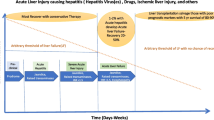Abstract
A 44-year-old male was pointed out liver function abnormality by medical check-up. Blood examination and computed tomography showed liver cirrhosis. Then, he was referred to our hospital for further examination. After blood test, viral markers revealed previous infection of hepatitis B virus (HBV). We estimated the etiology of his liver disease as previous HBV infection. On laparoscopic examination, his liver surface was nodular with mixed yellowish nodules and ash gray to copper-colored nodules in the diameter of 3–10 mm. There were large regenerative nodules in segments 3 and 4. Large regenerative nodules and irregular steatosis were contradictory to HBV-related liver cirrhosis, so then we supposed Wilson’s disease. The amount of copper excretion in the urine was 326.6 μg (>100 μg/24 h). After D-penicillamine administration, urinary copper excretion increased to 2151.5 μg/24 h. Though hepatic copper concentration was 174.5 μg/g wet tissue (>200 μg/g wet tissue), his laboratory data fulfilled the Leipzig diagnostic criteria proposed by EASL. Laparoscopic examination with liver biopsy has advantages to survey many disease-specific findings on liver surface and to obtain adequate liver sample. Laparoscopic examination is one of the effective procedures for diagnosing relatively rare liver disease like Wilson’s disease.



Similar content being viewed by others
References
Aoki T, Suzuki M, Fujioka Y et al. Nationwide survey of clinical feature of Wilson’s disease in Japan. In: Lam STS, Pang CCP, editors. Neonatal and perinatal screening: the Asian pacific perspectives, Hong Kong; The Chinese University Press; 1996.
Ferenci P, Caca K, Loudianos G, et al. Diagnosis and phenotypic classification of Wilson disease. Liver Int. 2003;23:139–42.
Wilson SAK. Progressive Lenticular degeneration: a familial nervous disease associated with cirrhosis of the liver. Brain. 1912;34:295–509.
Roberts EA, Schilsky ML. Diagnosis and treatment of Wilson disease: an update. Hepatology. 2008;47:2089–111.
Kalk H, Bruhl W. Leitfaden der Laparoskopie und Gastroskopie. Stuttgart: George Thieme; 1951.
Watanabe T, Sakauchi H, Takimoto M, et al. Utility of laparoscopic examination for the diagnosis of liver diseases. Endoscopia Digestiva. 2001;13:893–903.
Ohnishi S, Aoyama H, Nagase T, et al. Four cases of Wilson’s disease including three asymptomatic cases. Gastroenterol Endosc. 1986;28:1605–9.
Kusachi S, Shimada Y, Tobe K, et al. Peritoneoscopic study of Wilson’s disease. Gastroenterol Endosc. 1980;22:1060–71.
Noda S, Minami Y, Nishikawa M, et al. The relationship between change of unevenness and color on the liver surface and hepatic concentration of stainable copper in Wilson’s disease. Gastroenterol Endosc. 1986;28:947–55.
Beck K, Dischler W, Oehlert W. A color atlas of laparoscopy. Tokyo: Nankodo; 1981.
Kobashi H, Yamamoto K. The contemporary significance of laparoscopy in diagnosis of liver diseases. Nihon Shokakibyo Gakkai Zasshi. 2008;105:1453–61.
Disclosures
Conflict of Interest:
The authors declare that they have no conflict of interest.
Human/Animal Rights:
All procedures followed were in accordance with the ethical standards of the responsible committee on human experimentation (institutional and national) and with the Helsinki Declaration of 1975, as revised in 2008(5).
Informed Consent:
Informed consent was obtained from all patients for being included in the study.
Author information
Authors and Affiliations
Corresponding author
Rights and permissions
About this article
Cite this article
Muro, Si., Yasunaka, T., Wada, N. et al. A case of Wilson’s disease with characteristic laparoscopic findings. Clin J Gastroenterol 7, 175–179 (2014). https://doi.org/10.1007/s12328-014-0465-7
Received:
Accepted:
Published:
Issue Date:
DOI: https://doi.org/10.1007/s12328-014-0465-7




